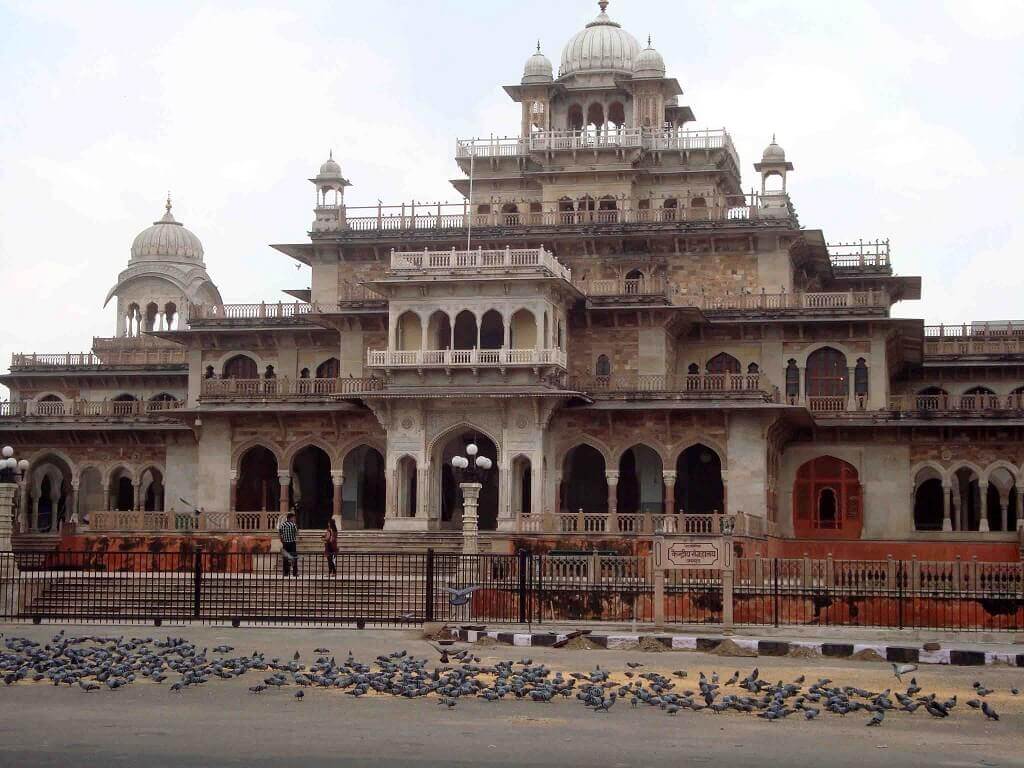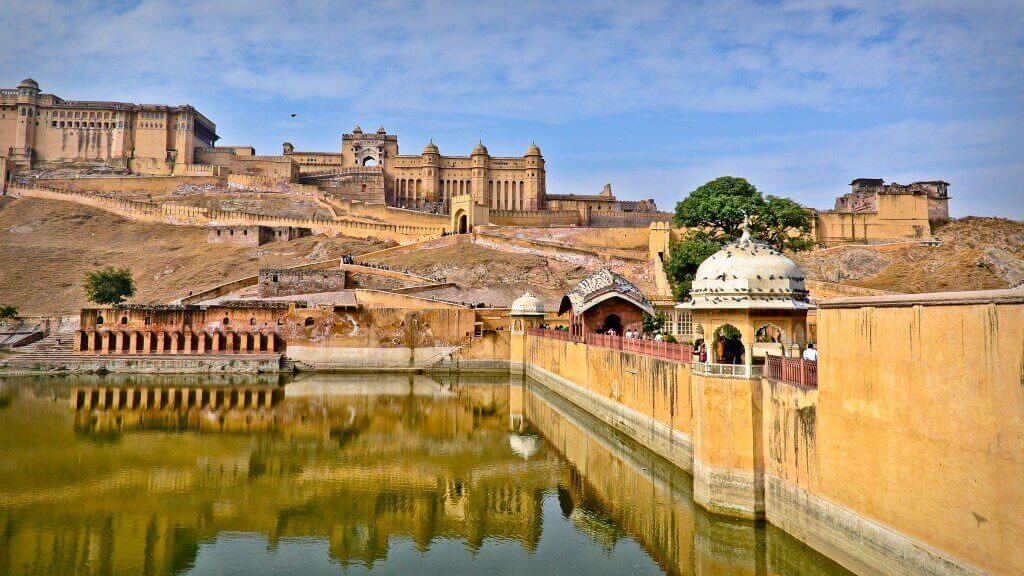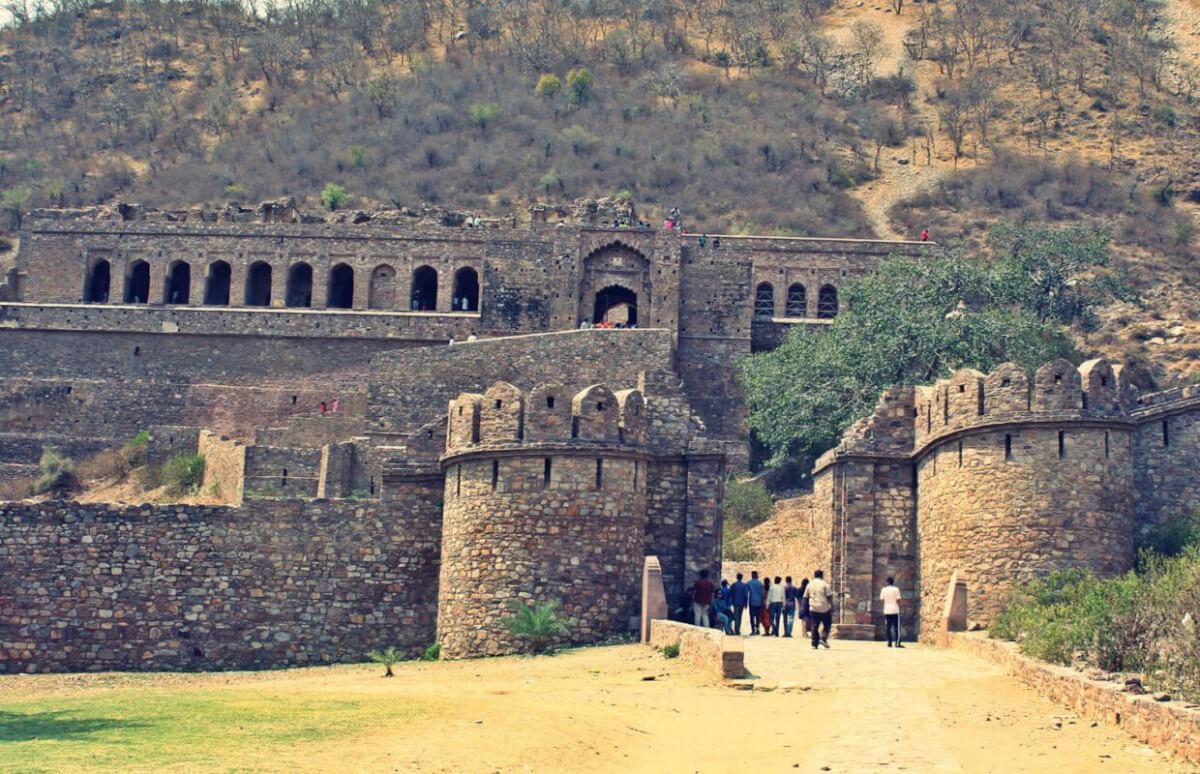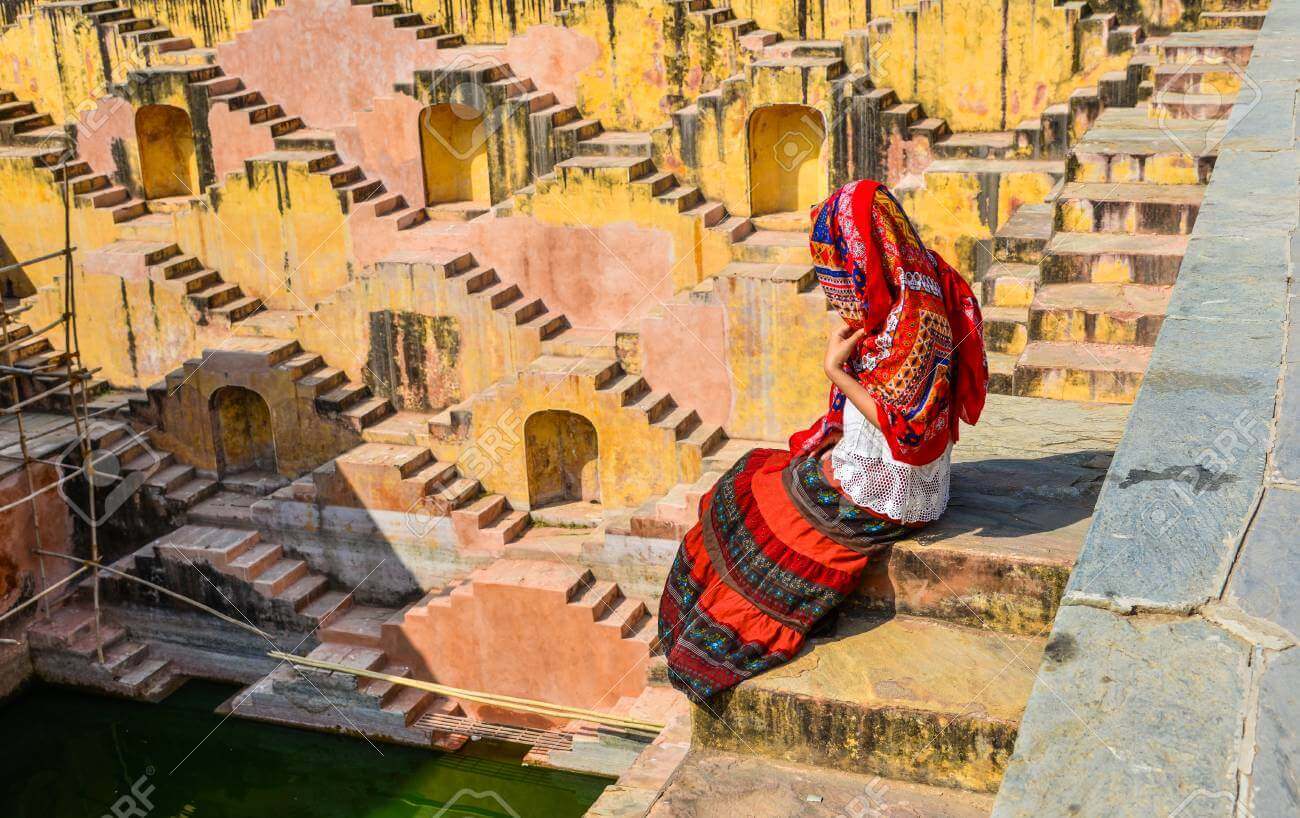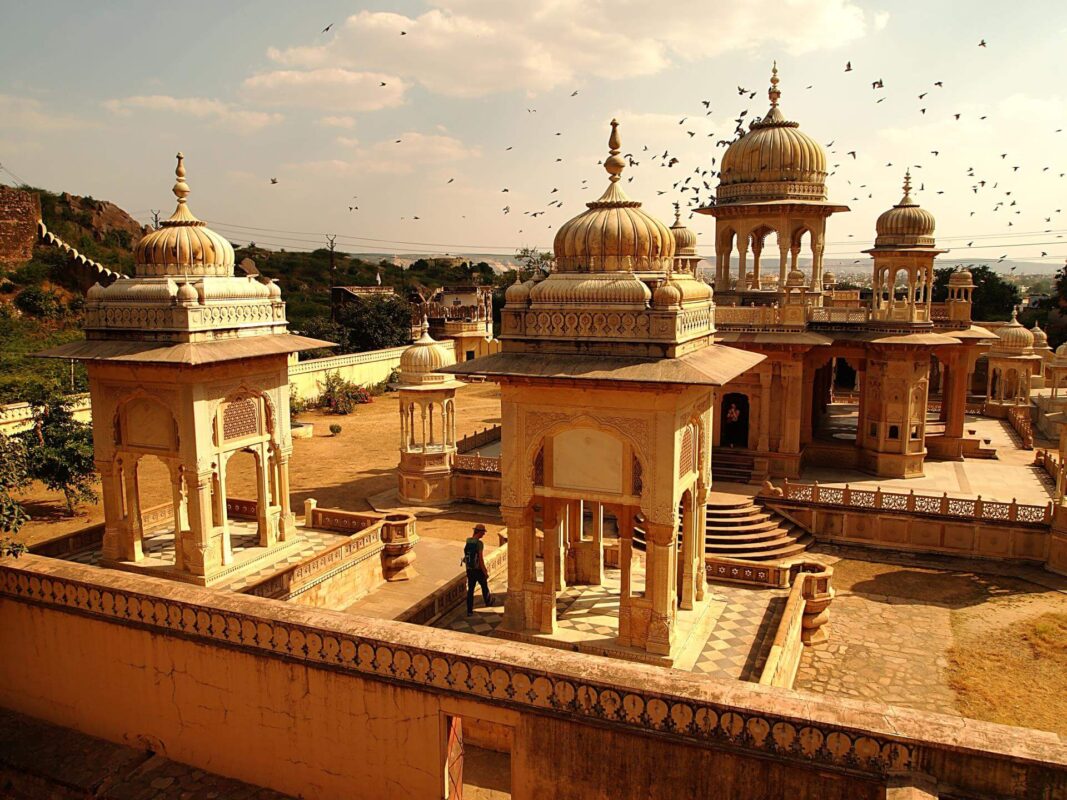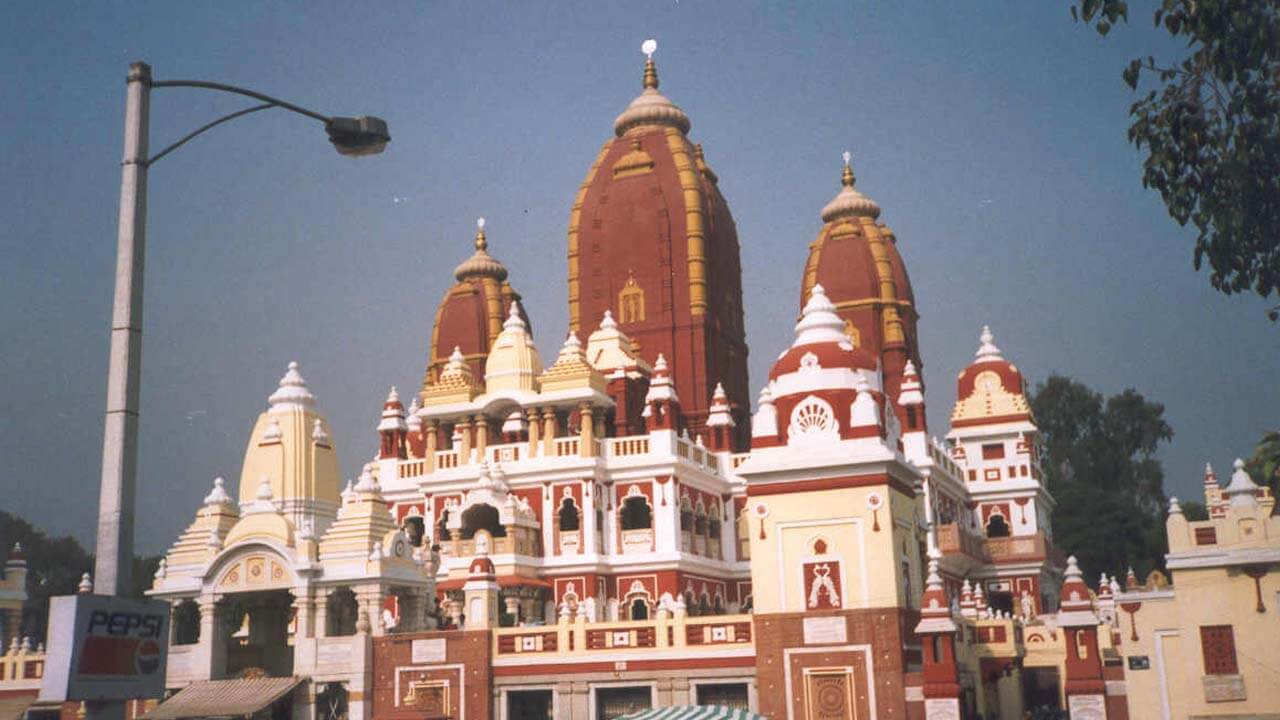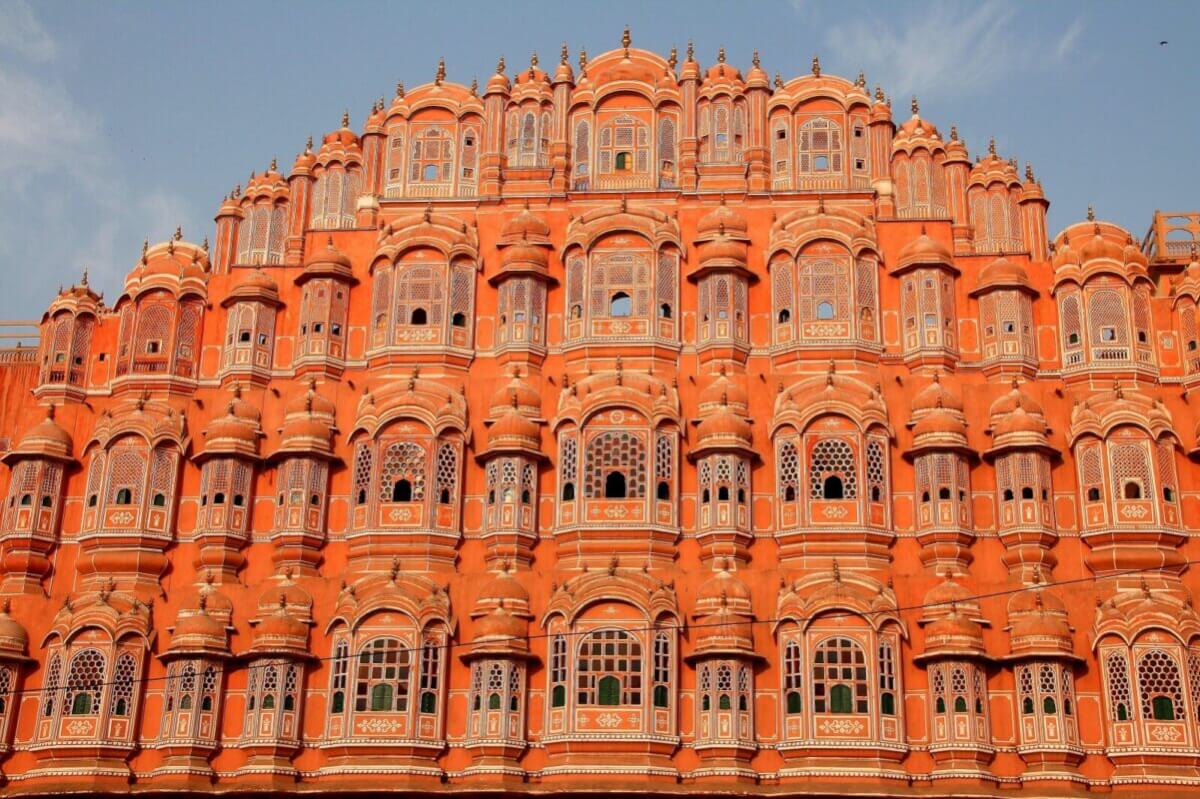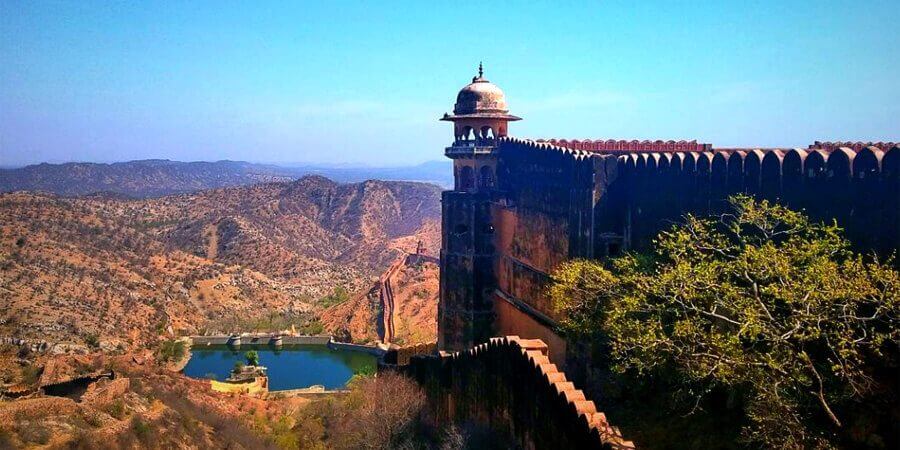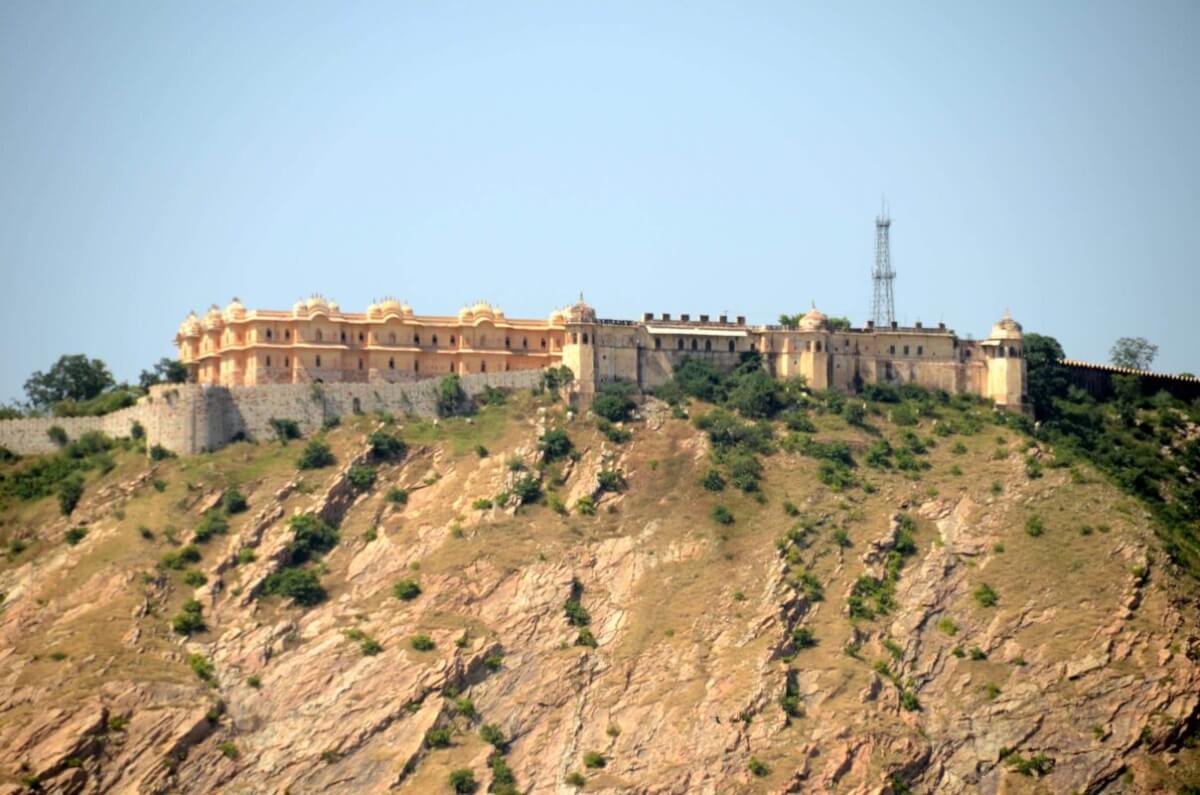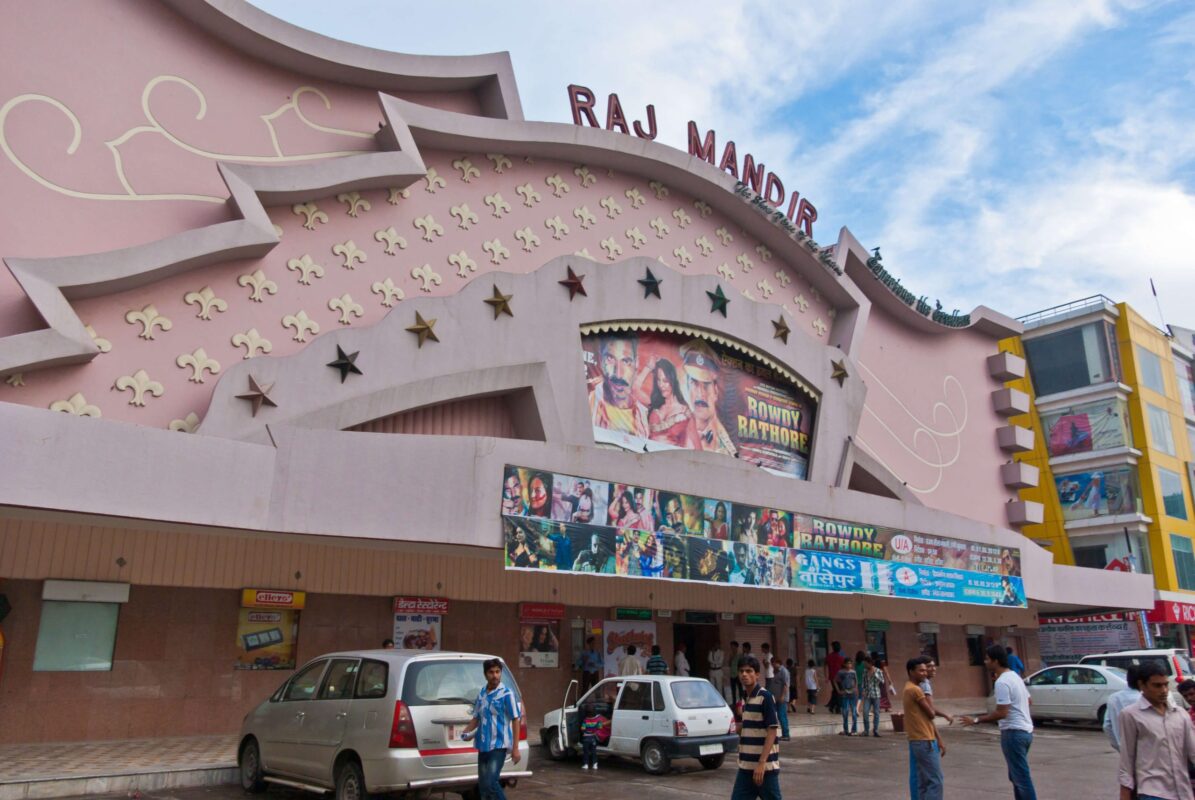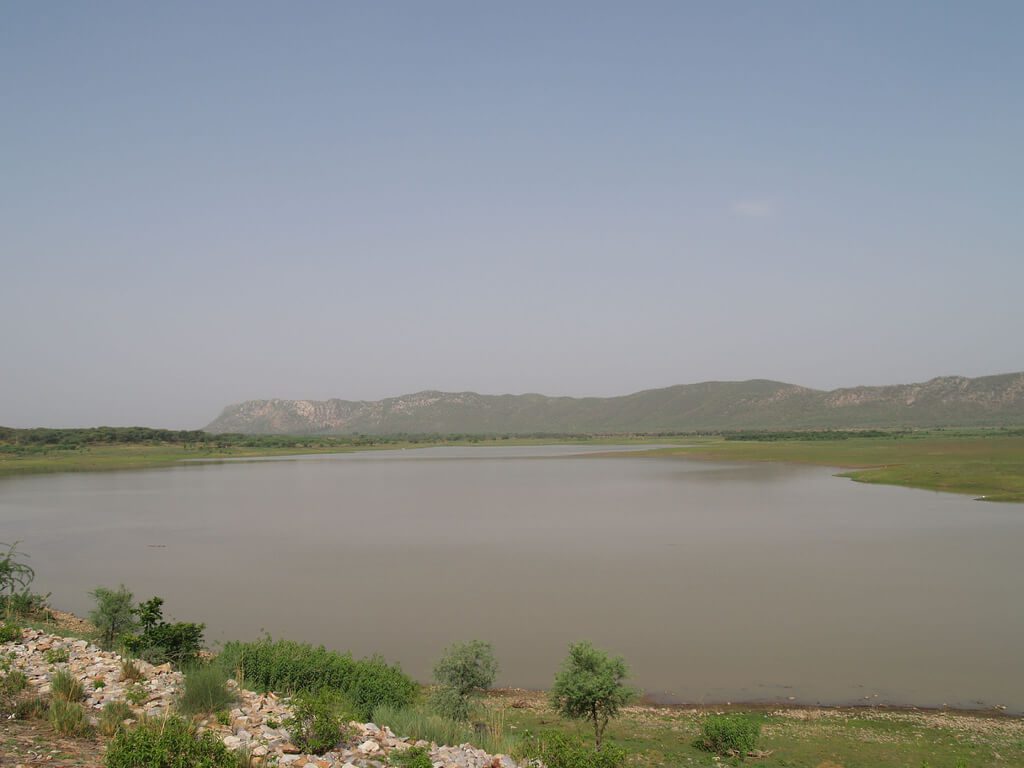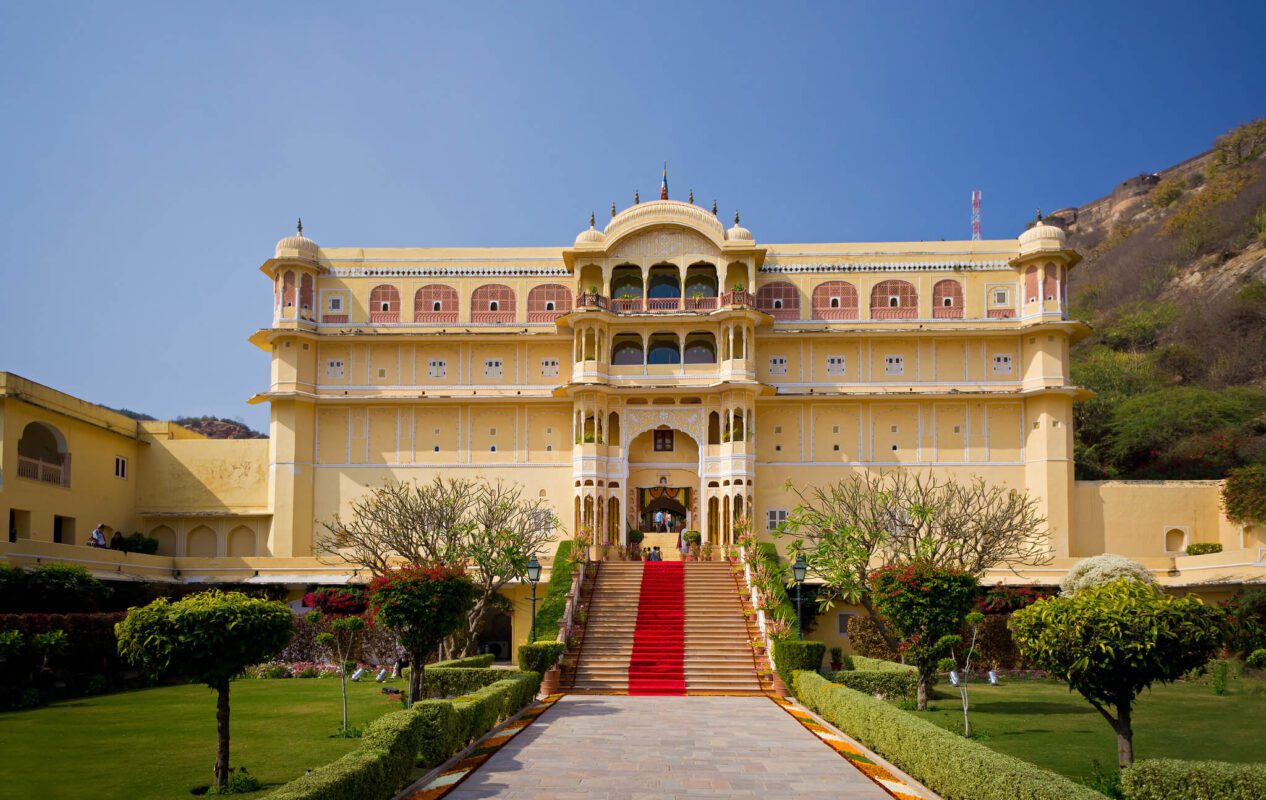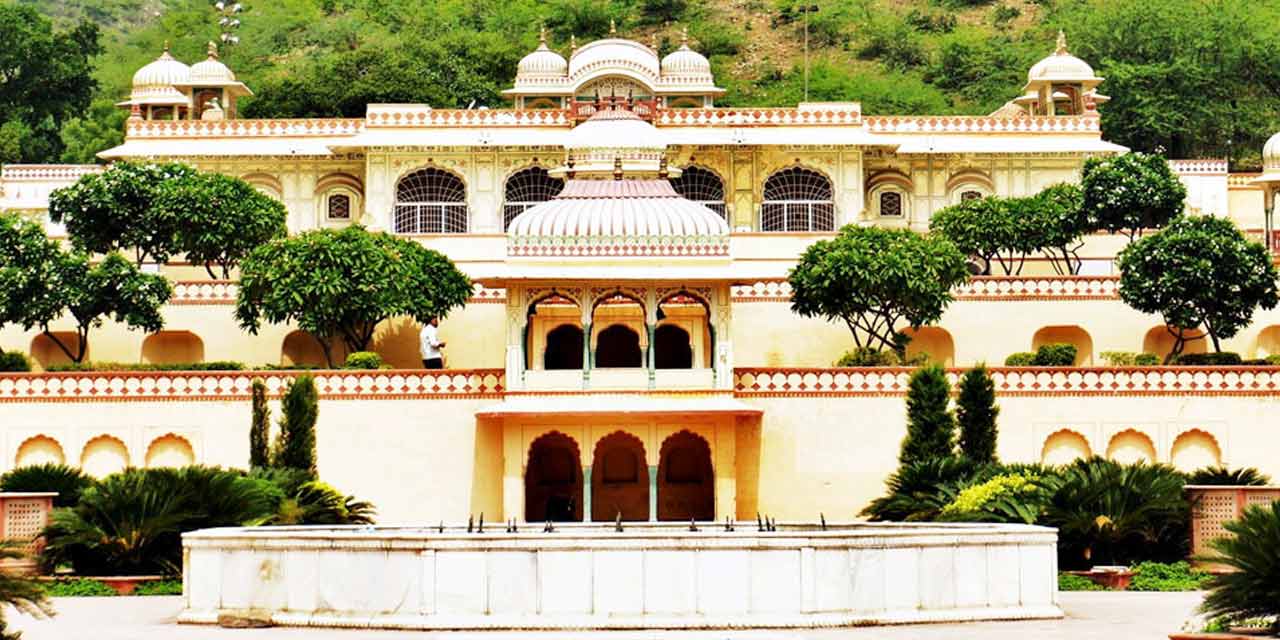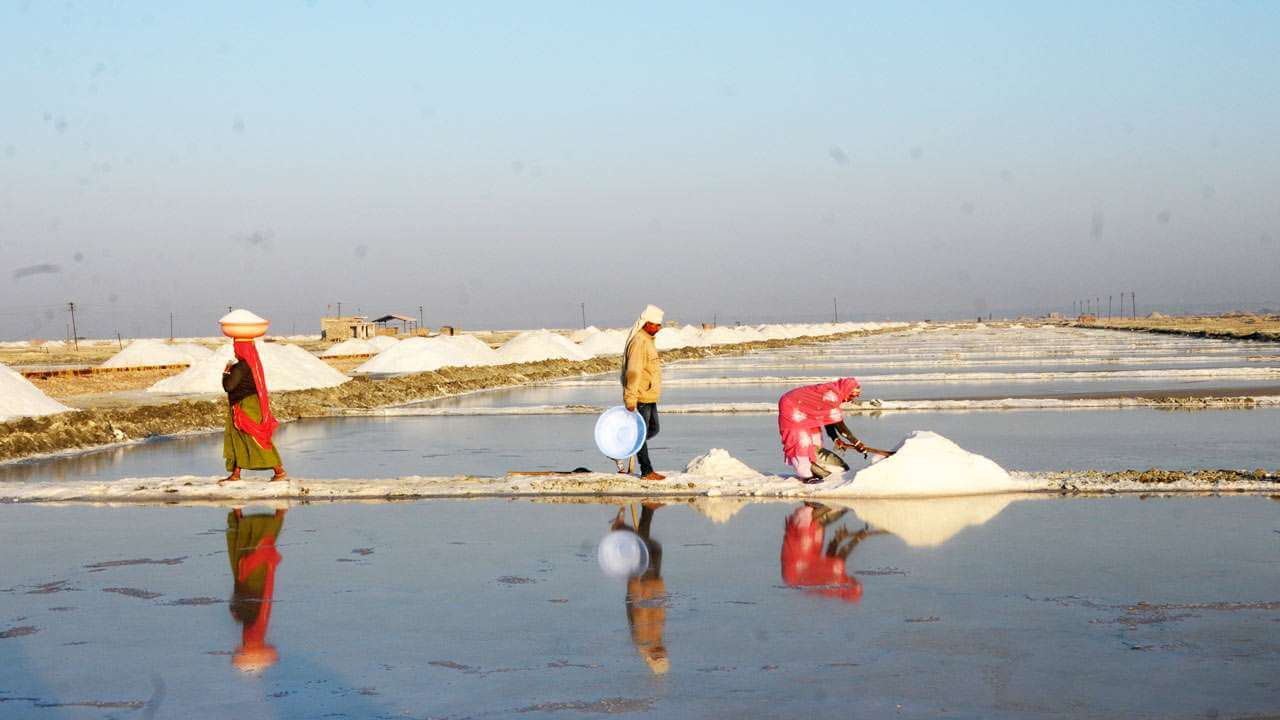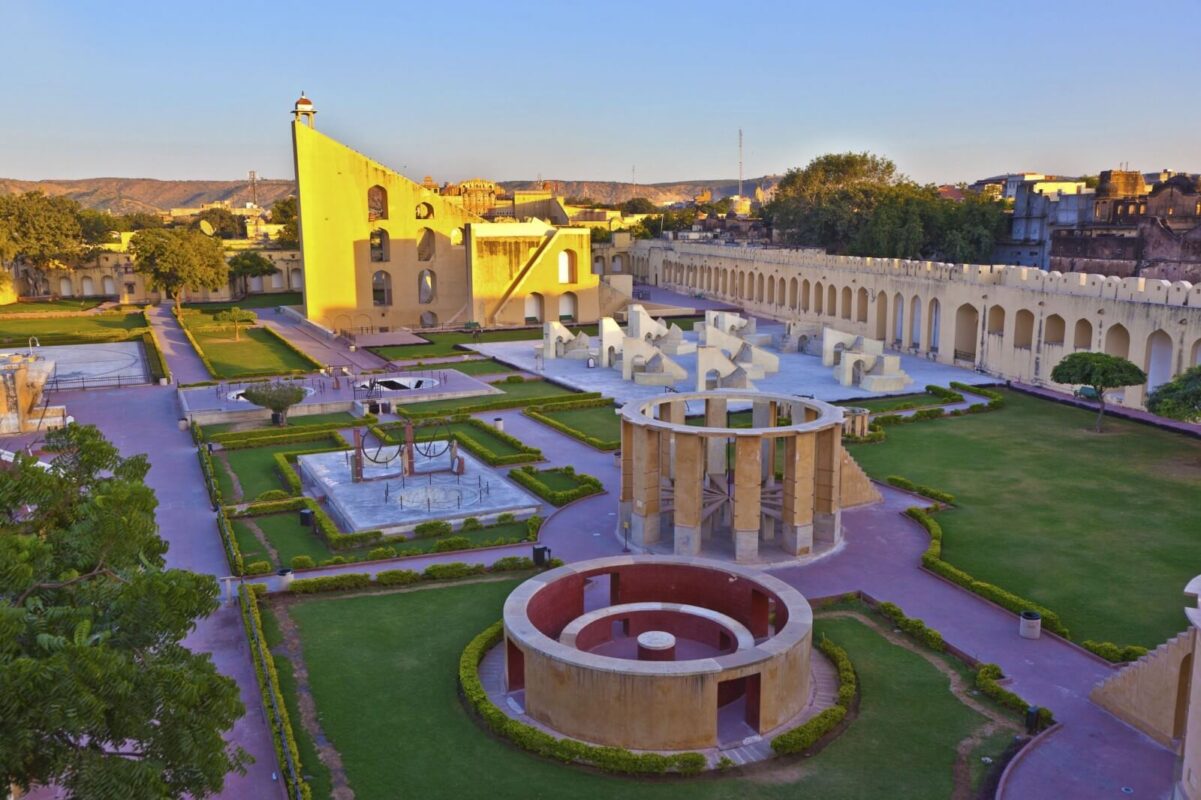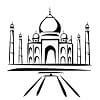- Home
- Holiday Ideas
-
-
- Choose Your Traveling Theme
-
- Adventure Tourism
-
- Cultural Tourism
-
- Tour Packages
-
-
- Packages by State
-
- Holidays by Interest
-
- Popular Tour Packages
-
- Fair And Festivals
-
- Ayurveda And Yoga
-
- Offers
-
- Destinations
-
Jaipur City of Palaces
Jaipur City of Palaces
The city of palaces and forts, interspersed with historical monuments and gardens that testify the grandeur of the Rajput kings, Jaipur is that the gateway to the royal heritage of India. Also called Pink City, the capital of Rajasthan, remains suspended in time, with its heritage preserved within the overwhelming Hawa Mahal that gazes down at the bustling streets of Johari Bazaar.
A little faraway from the town centre, which is resplendent with state-of-the-art cinemas/ movie theatres, eateries, multiplexes, museums and parks, lies the arid hilly country dotted with forts that earlier stood as armoured sentinels of Jaipur. the most important and therefore the most awe-inspiring is that the Amber Fort, which leaves one humbled with its expansive fortifications and grandeur.
Founded by Maharaja Jai Singh II in 1727 AD, Jaipur was the stronghold of the Rajputs, who gave it its everlasting legacy within the sort of various heritage sites, arts and crafts, culinary curations etc. Typical Rajasthani cuisine, comprising lal maas, dal-bati-churma, ker sangri and other uncountable recipes, all hold limelight within the culinary culture of India. These are often enjoyed within the quintessential Rajasthani sort of sitting cross-legged on mats on the ground and digging in within the sumptuous thali, which features up to twenty dishes.
While one can enjoy the varied offerings of the town as an outsider, what really sets Jaipur apart is its welcoming spirit that wins you over with its warmth. To symbolise this hospitable culture, the older a part of the town was painted pink under the reign of Maharaja Ram Singh in 1876. Although this was done during British rule when the Prince of Wales came to go to India, many homes are still adorned with the hue to reiterate their signature slogan of ‘Padharo Mhare Desh’ (Welcome to my Land).
Jaipur was designed by architect Vidyadhar Bhattacharya within the early 18th century. Through the years it’s transformed into a bustling metropolis while continuing to retain its old-world charm. Following India’s independence from British rule, Jaipur and therefore the principalities of Bikaner, Jaisalmer and Jodhpur came together to make this state of Rajasthan. Today, thousands of travellers from the planet over come to explore its vibrant streets per annum , sampling its delicious food and experiencing its rich cultural flavours. They find at every turn an enthralling confluence of tradition and modernity, old shops rubbing shoulders with new malls without ever detracting from the city’s essence.
A kaleidoscope of the many moods and hues, Jaipur is additionally an incredible shopping destination. From colourful puppets and bandhni sarees to silver jewellery and lac bangles, it offers a number of knick-knacks and souvenirs to require home along side many fond memories!
Attractions in Jaipur
Abhaneri
Boasting the famous Chand Baori stepwell and Harsha Mata Temple, Abhaneri is one among the foremost prominent tourist destinations in Rajasthan. This village lies about 45 km from the town of Jaipur. Chand Baori is a tremendous display of engineering and provides a desirable experience to the visitors. it had been created with the aim of harvesting rainwater and features a depth of 20 m with 13 levels. The Harsha Mata Temple is devoted to Goddess Harshat Mata, who is goddess of joy. This temple was inbuilt the 10th century.
Abhaneri was originally called Abha Nagri, which suggests ‘City of Brightness’. it had been inbuilt the 9th century. Abhaneri is additionally known for its local dances like kalbelia and ghoomer.
Albert Hall Museum
A magnificent building inbuilt Indo-Saracenic style of architecture , Albert Hall Museum (Central Museum) is found in Ram Nivas Garden. It draws its name from London’s Victoria and Albert Museum. Its corridors are decorated with murals reflecting various civilisations. Currently, the museum houses a various range of wood crafts, stone and metal sculptures, metal objects, carpets, natural stones, arms and weapons and goods made out of ivory. The museum also displays art from the Kota, Bundi, Udaipur, Kishangarh and Jaipur schools of art. The building’s stone was laid during the visit of Prince of Wales, Edward VII to Jaipur in 1876 and it had been completed in 1887 by architect Samuel Swinton Jacob, the then director of Jaipur PWD.
Amber Fort
Just 11 km outside Jaipur, lies the magnificent Amber Fort (Amer Fort), sitting atop a hill, and rising sort of a sentinel guarding the town . Commissioned in 1592 by Maharaja Man Singh I, the fort may be a fine blend of Rajput and Mughal architectural styles, and boasts a grand palace, temples and a number of other ornate gates. Built entirely of red sandstone with white marble work, the UNESCO World Heritage Site may be a picture of opulence and grandeur, set against a stark desert backdrop and rolling hills.
One can either walk up the wide winding uphill road to succeed in the most gate of the fort or hire a cab. As you meet up with to the huge gate, you realise why it had been considered almost impregnable by the enemy, when the royalty wont to reside here, before they shifted the capital to Jaipur. As you enter, you cross the Suraj Pol (sun gate), which results in the most courtyard called Jaleb Chowk. Diagonally opposite is that the Chand Pol (moon gate). From Jaleb Chowk, a flight of stairs leads up to the tiny Siladevi Temple, whose doors feature relief add silver.
The main palace is up next. It includes the Diwan-e-Am (hall for a personal audience with the king) with carved columns and latticed galleries, the king’s apartments, the gate Ganesh Pol with beautiful arches, and Jai Mandir or Sheesh Mahal. Stand at one among the various arched windows of the palace and absorb the rolling shrub land stretching up to the horizon and therefore the scenic Maota Lake at the foot of the fort. Even after centuries, it’s easy to imagine yourself as a Rajput king, who would stand here and survey his kingdom.
Sheesh Mahal or the mirrored palace is one among the foremost popular attractions here that pulls the most important number of tourists. it’s breathtaking with fine marble work and cut-glass and mirror inlaid designs on ceilings and walls. it’s said that in the dark , as earthen lamps flickered inside the hall, the various mirrors reflected the sunshine , creating the atmosphere of a start-lit sky. Hire a guide or an audio guide to understand more about the legends of the fort. within the evening, watch history wake up during a spectacular sound and lightweight show.
Bhangarh Fort
With the magnificence of the Aravalli hills behind it, Bhangarh Fort, falls midway between Jaipur and Alwar. It lies at a distance of nearly 50 km from the Sariska Wildlife Sanctuary and is believed to be a haunted place. However, it lures visitors both for its rich architectural heritage and picturesque surrounding views.
The fort was inbuilt the 17th century by one among the navratans of Akbar’s court, Man Singh I for his grandson Madho Singh I. The fort premises house temples, palaces and havelis. There are four entry gates to the fort, namely, the Lahori Gate, the Ajmeri Gate, the Phulbari Gate and therefore the Delhi Gate.
One legend related to the fort says that there was once a sage called Baba Balanath, who lived within the fort and never wanted the shadow of another house to the touch his own. A prince defying this diktat built a palace that overshadowed the house of the sage, who then cursed the town with mass deaths. Another story says that when a tantric called Singhiya wont to entice Princess of Bhangarh with sorcery . However, this didn’t work and therefore the tantric was sentenced to death. it’s believed that he then cursed the town. nobody is allowed to enter the fort before sunrise and after sunset.
Chand Baori
Chand Baori (a stepwell) located within the Abhaneri village, around 90 km from Jaipur, is one among the oldest and most photographed ancient monuments in Rajasthan. Built by King Chanda of the Nikumbha dynasty in 9th century AD, it’s one among the most important stepwells within the world. Chand Baori was built to conserve water and supply a respite from the extreme desert heat. This architectural wonder has 3,500 perfectly symmetrical, narrow steps and it’s this exquisite geometry that pulls thousands of tourists thereto per annum . The stepwell narrows together gets closer to rock bottom . A double flight of steps on three sides takes one to the surface of the water below. The fourth side may be a three-storeyed pavilion with intricately carved jharokhas (windows), galleries and balconies meant for the royalty to take a seat in.
City Palace
Located within the heart of old Jaipur, the town Palace may be a spectacular example of the amalgamation of Rajput and Mughal architecture. Commissioned to be built by the founding father of Jaipur, Maharaja Jai Singh II, this lavish palace includes the quarters of the erstwhile royalty , a number of whom still reside during a private wing. It also houses the Diwan-e-Am (hall for public audience with the king), Diwan-e-Khas (hall for personal meetings of the king together with his noblemen), Mubarak Mahal and therefore the Maharani’s Palace (queen’s palace). Mubarak Mahal houses the Maharaja Sawai Man Singh II Museum, which displays the royal family’s personal belongings like garments featuring exquisite embroideries. The Maharani’s Palace showcases one among the most important collections of weapons within the country. And at Diwan-e-Khas stands two gigantic silver vessels, each 1.6 m tall, which are said to be the most important silver objects within the world. They were supposedly wont to transport water from River Ganges for the royalty . The palace also boasts several rare artworks.
Gaitore
Set against the backdrop of yellow sandstone hills, Gaitore is that the place where former kings of Jaipur are entombed. Located just off the road resulting in Amber Fort, the white marble chhatris or cenotaphs here are inbuilt distinct Rajasthani style, with the intricacy of every chhatri reflecting the stature of the king buried beneath. the foremost magnificent one, with 20 finely sculpted pillars, belongs to Maharaja Jai Singh II (1688-1743), the founding father of Jaipur. Many believe that the carving on each cenotaph represents the taste of each king and therefore the culture that was prevalent at that point .
The word ‘Gaitore’ is believed to possess been derived from the Hindi phrase ‘Gaye ka Thor’, which suggests a resting place for the departed souls. Gaitore lies about 15 km from Jaipur.
Govind Devji Temple
Govind Devji Temple is situated within the City Palace complex and is devoted to Lord Krishna and Radha. The idols of the deities are believed to possess been brought from Vrindavan by Raja Sawai Jai Singh II, the founding father of Jaipur. Legend has it that Govind Dev Ji appeared within the dreams of Raja Sawai Jai Singh and asked him to bring his idol from Vrindavan to Jaipur and therefore the king did as per the wish of god. After his death, however, the development was overtaken by Raja Man Singh in 1890.
The idol of Govind Ji is taken out during the day for occasions just like the arti and bhogs, which are sweets offered in silverware. The temple is especially crowded during the festival of Janmashtami (birthday of Lord Krishna).
Hawa Mahal
Jaipur’s most iconic building, the pink Hawa Mahal, stands royally within the bustling Johari Bazaar. With a fine honeycomb of latticed windows, the five-storeyed monument lives to its name, which suggests the palace of wind. inbuilt 1799 by Maharaja Sawai Pratap Singh, Hawa Mahal was primarily constructed as a summer retreat for the royal household and was also employed by the royal ladies to enjoy the lively vibes of Johari Bazaar through the white framed windows, while they themselves stayed hidden from the people on the road . Interestingly, the arrangement of the windows is claimed to resemble the crown of Lord Krishna. Inside, there’s a museum that houses Rajasthani miniature art and out of doors may be a hub of stalls selling handmade jewellery, leather-crafted home decor items and therefore the region’s famous silver jewellery.
Jaigarh Fort
Renowned for housing Jaiban, the world’s largest cannon, the Jaigarh Fort, constructed by Maharaja Sawai Jai Singh II, is found about 15 km from the town of Jaipur. Constructed within the early 18th century, the formidable fort, built to guard Amber Fort from enemy invasion, sits majestically atop a craggy hill. Though built as a military structure, there are well-planned gardens within its premises, along side a residential district for the royals and temples. The fort is well-preserved and stands altogether its grandeur. it’s connected to the famous Amber Fort with subterranean passages and its architecture is extremely almost like the Amber Fort. One can get sweeping and picturesque views of the town of Jaipur from here. The fort also boasts an auditorium of warriors called Shubhat Niwas, a museum and an armoury. Many believe that the fort features a huge treasure buried thereunder .
The history of the fort is sort of interesting and it’s said that in the Mughal era, it became the empire’s main foundry of cannon and was also wont to store ammunition and other metal requirements of war. The outpost of Jaigarh Fort was protected by Dara Shikoh, who was defeated and executed by his brother, Aurangzeb. Then, the fort was given to Jai Singh II.
Jal Mahal
One of the foremost ethereal sights in Jaipur is that the architectural marvel of Jal Mahal, which is standing right at the centre of the person Sagar Lake. Conceptualised as a lodge by Maharaja Madho Singh I and restored by Jai Singh II in 1734, it’s built consistent with a mix of Rajput and Mughal aesthetics, with pink sandstone. The sandstone paints a vivid image against the blue backdrop of the water and therefore the distant rolling hills. The palace may be a five-storeyed building and about four storeys stay immersed when the lake is full. At night, bathed in dreamy lights, the palace seems as if it’s floating within the lake’s water. within the vicinity of the palace is that the gorgeous Chameli Bagh, which may be a paradise for birdwatchers. a number of the avifauna one can spot here includes pochard, coot, flamingo and kestrel.
Nahargarh Fort
Built as a fortress and a stronghold to keep off enemy invasions, the impressive Nahargarh Fort marks the northern end of Jaipur. Sitting on a ridge within the Aravalli range, the fort was constructed in 1734 and expanded in 1868. a stimulating story says that the fort was named after a dead prince, Nahar Singh, whose restless spirit demanded that the structure be named after him. Offering fantastic views of the town , the fort looks astounding in the dark , bathed in bright lights. The architecture of the fort is breathtaking in its majesty and one can see traces of Indo-European styles. ‘Tadigate’ is that the entrance gate and to its left lies a temple dedicated to the gods of the rulers of Jaipur. Another temple inside the fort, dedicated to Rathore prince, Nahar Singh Bhomia, is additionally worth a visit.
An interesting feature of the fort is that the Madhavendra Bhawan built by Sawai Madho Singh. it’s a two-storey building with suites for both the king and his wives. The suites bear the marks of Indian architecture with European embellishments like rectangular casements along side European-styled lavatories. The rooms and suites are linked to every other via hallways and therefore the interior boasts beautiful frescoes. the ladies quarters are inbuilt such how that the king could visit any of his queens without the others knowing. The names of all the nine queens had been emblazoned on the doors to avoid confusion.
Rajmandir Cinema
Rajmandir Cinema is one among the simplest locations within the city to observe a movie in. It gives its guests not just movie entertainment but also makes them desire a royal guest of a palace. Its high ceilings are ornamented with chandeliers and its walls are adorned with custom-made wooden tiles with glass inlay work. One unique feature of the theatre is its lighting system that illuminates the lobby with white light before the show starts and within the interval, a powerful blue light bathes the theatre. A natural floral scent wafts through the air making the experience of watching a movie an unforgettable one.
The architecture of the building is gorgeous due to which it had been given the title of ‘Pride of Asia’. the inspiration stone of the cinema was laid in 1966 by the then chief minister of Rajasthan, Mohanlal Sukhadia. This large-sized, meringue-shaped auditorium took ten years to shape and was inaugurated in 1976.
The first Indian movie ever screened here was Charas starring Dharmendra and Hema Malini.
Ramgarh Lake
Ramgarh lies at a distance of about 35 km from Jaipur and is understood for its reservoir . cover a neighborhood of 15.5 sq km, this lake, called as Ramgarh lake, was once a serious source of water for the town . This man-made water body was created by forming an embankment on verdant hills and now attracts many tourists per annum . the simplest time to go to it’s during monsoons when it’s flooded with water and presents a very enchanting view. It also appeals to birdwatchers as they will sight many migratory birds here. within the 1982 Asian Games, this lake also hosted an occasion of rowing.
The region of Ramgarh was once the hunting ground of the Maharaja of Jaipur. Today one can spot wildlife like chital and nilgai here. Thus, it’s been pronounced as a wildlife sanctuary by the govt of India. One also can visit the Polo Grounds located here which are considered to be one among the simplest within the country.
Samode Palace
Located around 40 km from Jaipur, the just about 500-year-old Samode Palace is that the perfect example of Rajput haveli architecture. Visitors to Samode can experience the agricultural lifestyle by taking a camel safari through the village and visit local craftsmen.
Samode Palace is different within the way that it doesn’t belong to any royalty but to a family of noblemen, the Rawals of Samode. The roots of the family are often traced back to Prithvi Singh of Amber (1503-1528), who was the 17th prince of the house of Kachwaha Rajputs, who are believed to be the descendants of Lord Rama.
The noblemen of Samode are bestowed the title of ‘Maha Rawal’ for his or her bravery and loyalty towards the throne.
Sisodia Rani Palace and Garden
Located 8 km from Jaipur, the Sisodia Rani Palace and Garden was constructed by Maharaja Sawai Jai Singh II for his queen Sisodia, a princess of Udaipur, in 1728. He gifted the garden to the queen to spend her idol time in. Laid call at a mix of Mughal and Indian styles, it’s a multi-tiered garden with built-in waterways, fountains and pavilions. While the spires and therefore the pavilions are crafted in Indian style, the flowerbeds, fountains and water channels reflect Mughal style. A spring and little shrines dedicated to Lord Shiva, Lord Hanuman and Lord Vishnu also are worth visiting. The garden overlooks the palace that houses paintings of hunting scenes and scenes from the legends of Lord Krishna and Radha.
Sambhar Lake
This is an outsized inland saltwater lake just 70 km from Jaipur. With a stark but stunning white landscape, it’s a birdwatcher’s paradise. The word ‘sambhar’ means ‘salt’ and therefore the lake is known as so as its surrounding regions have high concentrations of salt. This lake has been classified as a Ramsar site (wetland of worldwide animation) and is home to flamingos, which are a serious attraction of this place. One also can spot an outsized number of pelicans here. Sambhar lake has been mentioned within the epic Mahabharata also and therefore the story says that the lake was a part of the dominion of a devil lord called Brishparva. Goddess Shakambari Devi turned the plains of the town into a mine of valuable . However, since people were worried that such wealth would corrupt many, the goddess turned it into a reservoir of salt.
Jantar Mantar
Constructed by Sawai Raja Jai Singh, the ruler of Amber, between 1725-1730 AD, Jantar Mantar was built to assist Hindu astrologers and students with their studies and research; particularly the collation of astronomical tables and therefore the prediction of movements of the sun, the moon and therefore the planets. it’s one among the five observatories that were constructed in India during the 18th century by the raja; the opposite four are in Delhi, Mathura, Jaipur and Varanasi. the first instruments installed here with the assistance of Raja Jai Singh include the Sundial, Nadi Valay Yantra, telescope , Digyansa Yantra and Shanku Yantra. There are plaques and see boards everywhere the place carrying information in both Hindi and English to elucidate the workings of several instruments. Also referred to as Ved Shala, the building houses masonic instruments that are still getting used to hold out research. The observatory may be a n architectural marvel and is a must-visit within the city.
The Jantar Mantar, in Jaipur, is an astronomical observation site inbuilt the first 18th century. It includes a group of some 20 main fixed instruments. they’re monumental examples in masonry of known instruments but which in many cases have specific characteristics of their own. Designed for the observation of astronomical positions with the eye , they embody several architectural and instrumental innovations. this is often the foremost significant, most comprehensive, and therefore the best preserved of India’s historic observatories. it’s an expression of the astronomical skills and cosmological concepts of the court of a scholarly prince at the top of the Mughal period.
How to get there
By Air
Jaipur has a well-connected airport with daily flights to and from Mumbai, Delhi, Ahmedabad, Kolkata, Udaipur, Jodhpur, among others. Also known as Sanganer Airport, the international terminal operates flights to and from Dubai.
Rail
Trains from major Indian cities like Delhi, Mumbai, Kolkata, Chennai, Ahmedabad, Agra etc. go to Jaipur. There is also trains running between Jaipur and Udaipur, Bikaner and Jodhpur.
By Road
Jaipur can be reached via the extensive state and national highways of India. Delhi is 260 km away. Buses, AC and non-AC, ply from all major cities of Rajasthan.
WANT TO RENT A CAR IN INDIA ?
Choose Your Traveling Theme



